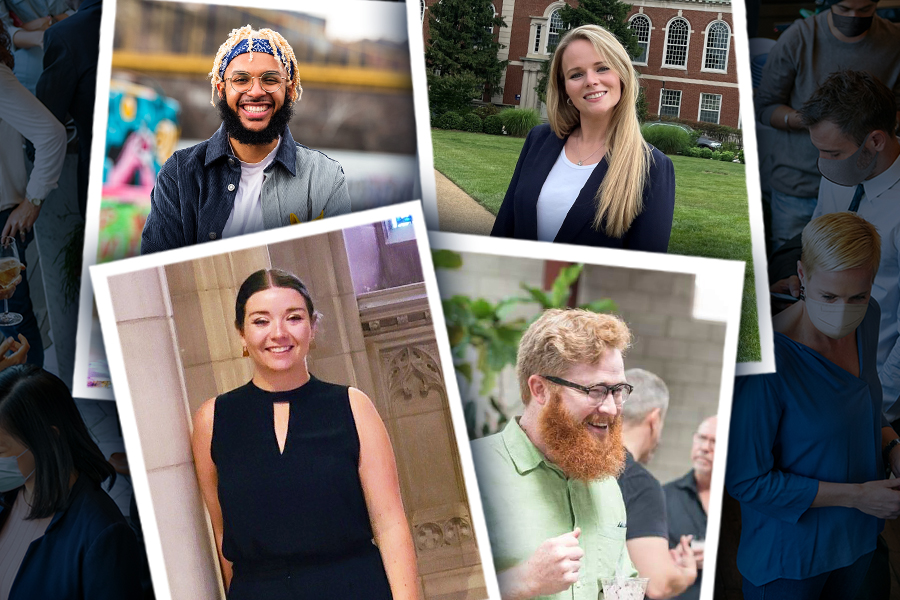
The Times, They Are A-Changin’ for Arts and Cultural Organizations
COVID-19's impact on arts organizations is significant, but industry insiders offer insight about the path forward and see cause for hope.
By Jennifer Monahan
Like every industry on the planet, navigating COVID-19 has proven tricky for those working in the arts and cultural sector. Directing an orchestra, running museum operations or managing a theater company are challenging ventures under the best of circumstances. Doing so when a global pandemic keeps your audience at home requires a whole new playbook.
In many ways, the pandemic not only caused us to consider what matters most, but also confirmed a collective understanding about the value of artistic endeavor.
“The arts teach us how to be human. They make you cry. They make you laugh, and they make you ponder about your life,” said André Solomon (HNZ 2020), community knowledge manager for Creative Generation.
Connecting with others and creating meaning through art are fundamental to our very humanity. Creative acts allow us to express the soul of who we are as a society.
During the pandemic, when people faced isolation, loneliness and despair, arts and cultural organizations offered a lifeline. Many people found comfort and joy in outdoor concerts and virtual museum visits.
 “The arts teach us how to be human. They make you cry. They make you laugh, and they make you ponder about your life.”
“The arts teach us how to be human. They make you cry. They make you laugh, and they make you ponder about your life.”
ANDRÉ SOLOMON (HNZ 2020)
COMMUNITY KNOWLDEGE MANAGER FOR CREATIVE GENERATION
Closures and Lifelines
Essential though arts organizations may be, COVID-19 has had a seismic impact on the industry.
Brad Carlin (HNZ 2006) is a senior consultant at TRG Arts, an organization focused on building resilience in the arts and cultural industry. He has been closely involved in tracking the effects of the pandemic and creating strategy to address the changes.
“When the worst of pandemic was happening and we saw venues close, we saw massive shifts into online engagement,” Carlin said.
Prior to the pandemic, most theaters and performing arts organizations would have scoffed at the idea that their audiences would ever be moved by — or want to stay connected to — their organizations digitally. The opposite turned out to be true. Digital engagement offered a lifeline for both community members and those organizations.
While digital programming was effective for many organizations during the most intense part of the pandemic when lockdowns were in place, audience appetite has not continued. Engagement around digital programs has declined massively since the summer of 2021. Carlin said that although some organizations have seen continued success with pandemic-style digital offerings, it is by far the exception.
For those who work in the arts and cultural organization sectors, the closure of facilities and the end of in-person performances had immediate and acute financial implications. Government intervention, in the form of the CARES Act and the American Rescue Plan, was instrumental in keeping the lights on and the staff on payroll.
Philanthropy has been another key factor in sustaining these organizations throughout the pandemic. Carlin said that donors were remarkably generous in donating the value of their tickets and contributing to financial appeals to keep organizations alive.
Vann Ellen Mitchell (HNZ 2014) is a senior vice president at CCS Fundraising and partners with nonprofit organizations. Mitchell said overall giving to arts and cultural organizations was down by about eight percent in 2020. Though fewer individuals contributed, those who did gave larger amounts. That donor loyalty underscores how much benefactors value arts and cultural organizations. Philanthropy in the industry rebounded in 2021; giving to the arts and cultural sector was up 20 percent from 2020.
The pandemic also highlighted the outdated infrastructure in an underfunded industry.
“COVID-19 really unearthed this historical lack of funding for arts and culture, and then they were expected to adapt so quickly,” Mitchell said. Organizations that were able to pivot to create online experiences such as virtual museum tours or symphony performances in the park were a boon and a balm during a difficult time, but many did not have the staff structure or financial resources to innovate quickly.
Nevertheless, in an industry predicated on originality, many organizations responded with resourcefulness and creativity to ensure their communities had access to art, music and museums.
 “COVID-19 really unearthed this historical lack of funding for arts and culture, and then they were expected to adapt so quickly.”
“COVID-19 really unearthed this historical lack of funding for arts and culture, and then they were expected to adapt so quickly.”
VANN ELLEN MITCHELL (HNZ 2014)
SENIOR VICE PRESIDENT, CCS FUNDRAISING
Changing Demographics
Another industry-wide change highlighted by the pandemic is a shift in audience.
Baby Boomers — who generally have more discretionary time and income than their Gen X or Millennial counterparts — have traditionally been the most loyal theater-goers. They have also been the slowest to return to in-person programming. Though Boomers still comprise the largest group of patrons, their size has declined proportionally. The good news is that attendance has risen slightly for younger generations.
The change was inevitable, Carlin said, though it would likely have happened more gradually without the pandemic.
 “We've seen organizations use this time to ask some really deep, hard questions about who they are looking to serve: How can we be the most relevant organization to our community? Are we serving who we need to be serving? And if not, what are the things we can start to do to make that change?”
“We've seen organizations use this time to ask some really deep, hard questions about who they are looking to serve: How can we be the most relevant organization to our community? Are we serving who we need to be serving? And if not, what are the things we can start to do to make that change?”
BRAD CARLIN (HNZ 2006)
SENIOR CONSULTANT, TRG ARTS
COVID-19, the Arts, and Community Relevance
Arts managers from various perspectives said both COVID-19 and the national conversation about race served as catalysts for the industry to reexamine community relevance.
Kathleen Hill (HNZ 2020) is a senior associate for research and outreach at WolfBrown, where she focuses on program evaluation and strategic planning. Hill believes that arts and cultural organizations provide a comfortable and safe space to experience difference and serve as a powerful tool to recognize our common humanity.
Diversifying the racial and socio-economic make-up of audiences is a significant issue for arts and cultural organizations, and one silver lining of the pandemic is that it allowed these organizations the space to reflect.
“We've seen organizations use this time to ask some really deep, hard questions about who they are looking to serve: How can we be the most relevant organization to our community? Are we serving who we need to be serving? And if not, what are the things we can start to do to make that change?” said Carlin.
Solomon, whose area of expertise is community engagement, said that success hinges on authentic relationships and honest communication with audiences.
“If you build a theater or install public art with the mindset of ‘fixing’ a community, you may end up actually pushing that audience out or just doing a disservice overall to the people who live there,” Solomon said.
To thrive in and benefit a community, organizations have to spend time building relationships with community members. Asking audiences what they want in their community, and actually listening to the answers is imperative.
Solomon cited the Cleveland Public Theater and Carnegie Hall’s Ensemble Connect as doing effective and authentic engagement with new audiences.
The Chicago Symphony Orchestra created Notes for Peace in 2017, which empowers parents who have lost children to gun violence to create original songs of tribute. Carnegie Hall’s Lullaby Project pairs new parents in homeless shelters, high schools, foster care and correctional facilities with professional artists to write and sing personal lullabies for their babies. Both are compelling examples of relevant community partnerships, Hill said.
 “The arts sector is more diverse than it was, but not as diverse as it needs to be.”
“The arts sector is more diverse than it was, but not as diverse as it needs to be.”
KATHLEEN HILL (HNZ 2020)
SENIOR ASSOCIATE FOR RESEARCH AND OUTREACH, WOLFBROWN
Forging a Path Forward
Though trends have been positive overall for most of the last year, the aftershocks of COVID-19 are still being felt. The most recent data shows that ticket sales are still 20 to 30 percent behind where they were in 2019.
“Planning cycles and season cycles are all out of whack,” Carlin said. “We're only just now getting to the point where many organizations are able to plan a normal season on a normal cycle and timeline, and start thinking about putting it on sale. It will probably be another year or even two before we get a real sense of what recovery looks like.”
One positive thing to emerge during the pandemic was the creation of new types of donor relationships. Less engaged audience members — those who might purchase tickets for a live theater performance every year or two rather than owning season tickets, or visit a museum once a year rather than signing up for a membership — stepped in with financial support when they saw the risk of such organizations closing. The challenge for arts and cultural organizations now is how to keep these new audiences engaged.
The answer is a multi-pronged approach.
Arts and cultural organizations need to be thinking strategically about the right product mix for their community. Big, spectacular, familiar shows draw in audiences, but lesser-known, developmental work has an important place as well — and it’s the latter that tends to appeal to the most loyal theater-goers.
“The way forward is in deepening relationships with the audiences, with the supporters, with the donors and the members and the subscribers that you have,” Carlin said, “while strategically and selectively looking at where you want to grow your audience and with whom and why.”
Attention to inclusivity — both within the industry and within the community — will be an important part of whatever a “new normal” looks like, adding a wider variety of perspectives and stories.
“The arts sector is more diverse than it was,” Hill said, “but not as diverse as it needs to be.”
Showcasing the potential career paths — as artists, performers, arts administrators, etc. — available to young people is part of the solution. Shifting the industry towards a healthier work-life balance is also an important part of the equation.
The arts sector, like many others, is experiencing a time of “churn,” Carlin said. People are leaving jobs for better-paying positions, less demanding hours or more flexible work environments.
The pandemic inspired a period of inquiry for organizations because they could no longer do things as they had been done in the past. For those who are bold enough to take advantage, the circumstances offer a chance to reimagine the way they do things.
While the industry’s landscape changed over the course of the pandemic, the importance of artistic expression has not.
“People still care deeply about the arts and culture and their communities on the other side of this,” Carlin said. “They still want to be in a room with other human beings and experience the kind of magic of live performance. There are artists still making incredible, meaningful and important work. There are still people who want to see it. They still use arts and culture as a way to make their lives better. That's incredibly encouraging.”

